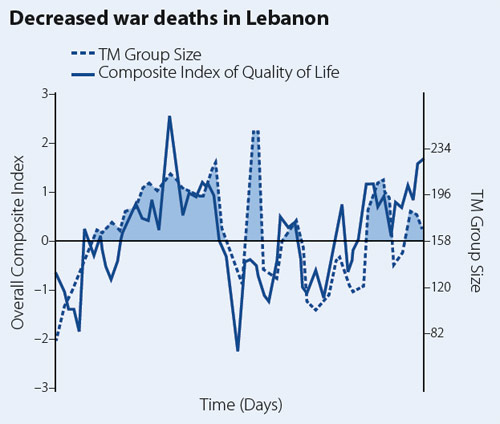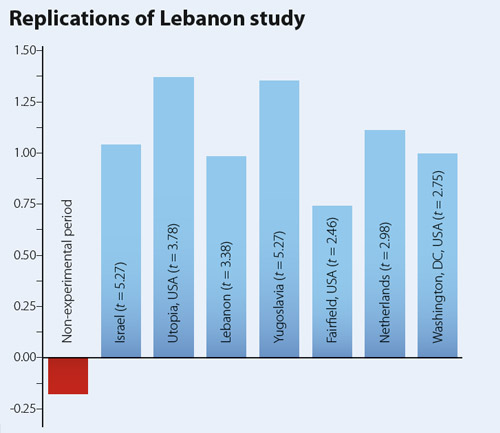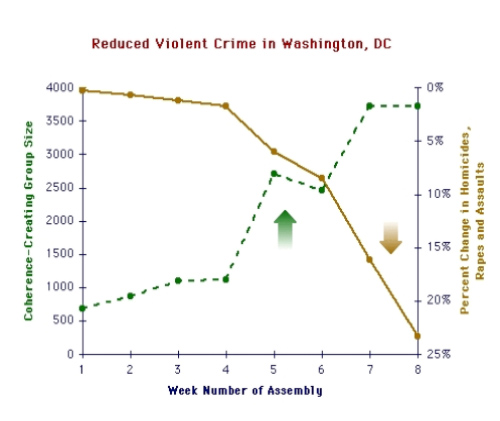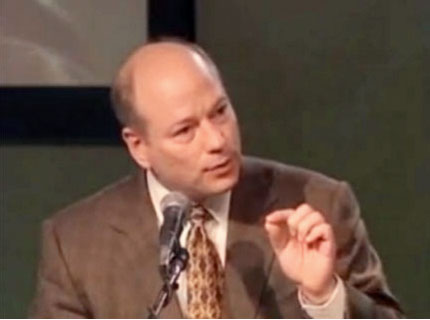The Maharishi Effect
2. A Field Effect of Consciousness
This phenomenon is known as the Maharishi Effect, in honour of Maharishi who predicted it in 1960, fifteen years before it began to be empirically validated by scientific research.
1. Extended Maharishi Effect
In 1976, Maharishi introduced the TM-Sidhi programme and that changed everything. The power of harmony multiplied.
With the TM-Sidhi programme the square root of 1% of a population is enough to create the same effect, if they are gathered in one place. So a group of 317 Sidha’s in one place has the same effect as 100,000 Meditators.
Scientific studies measuring the effect of Transcendental Meditation on society have established that the peace-promoting influence generated by a group of people practicing TM extends far beyond the members of the meditating group. If the group is made up of Yogic Flyers – those trained in the advanced TM-Sidhi programme – studies show that the square root of 1% of the population is sufficient to create a significant beneficial influence.
THE WASHINGTON STUDY
Violent crime was reduced by almost 25% in Washington DC when a group of 4,000 Yogic Flyers assembled for several weeks in the summer of 1993 (see chart). This research was published in the peer-reviewed journal Social Indicators Research 1999 47(2):153-201.
Global Maharishi Effect
The evidence shows that a group of Yogic Flyers equal to the square root of 1% of a population will bring peace to the whole society. As the square root of 1% the world’s population of 7.6 billion is 8,717, the target for the group of Vedic Pandits has been set at 9,000.
This means that only a few hundred or a few thousand individuals are needed to produce an extremely powerful and scientifically demonstrable effect of peace, harmony and prosperity in the surrounding society – even on a national or global scale. For the whole world, a group of 9,000 (roughly the square root of 1% of the world’s population) is needed. This is the target size for our group of Maharishi Vedic Pandits in India.
2. A field effect of consciousness
How is it possible that people practicing Transcendental Meditation alone in their homes or offices, or together in a group, can influence other people across town, across the country or even around the world – who aren’t even meditating?
The influence of the meditating group travels through an underlying field – in the same way that you can hear a live radio programme broadcast from the other side of the world. In the one case, the electromagnetic field links the radio station and your radio. In the other example, the field of consciousness links the meditator to the rest of the population. Waves of coherence from the peace-creating group spread throughout the field of consciousness, producing a beneficial and measurable influence throughout society.
3. Decreased Armed Conflict
A critical experimental test of the approach used by the Global Peace Initiative was conducted during the peak of the Lebanon war. A day- by-day study of a two-month assembly of people practicing advanced Transcendental Meditation in Israel in 1983 showed that, on days when the number of participants (“TM Group Size” right axis in chart at left) was high, war deaths in neighboring Lebanon dropped by 76% (p < 10-7). In addition, crime, traffic accidents, fires, and other indicators of social stress in Israel (combined into a Composite Index) all correlated strongly with changes in the size of the peace-creating group. Other possible causes (weekends, holidays, weather, etc.) were statistically controlled for. This study was published in the Journal of Conflict Resolution, 32(4):776-812 (1988).
These results were subsequently replicated in nine consecutive experiments over a two-year period during the peak of the Lebanon war. The results of these interventions included:
- war-related fatalities decreased by 71%
- war-related injuries fell by 68%
- the level of conflict dropped by 48%
- cooperation among antagonists increased by 66%
The likelihood that these combined results were due to chance is less than one part in 10-19 making this approach of reducing societal stress and conflict the most rigorously established approach in the history of conflict management.



